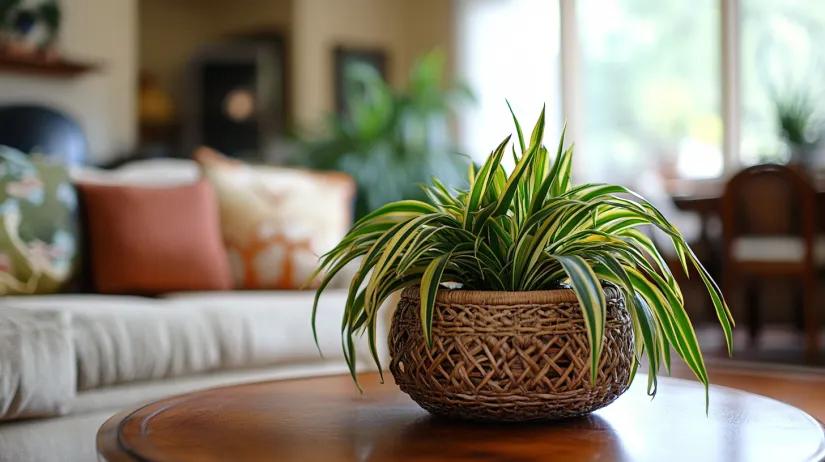The Best Air Purifying Plants for Your Home

Indoor air pollution is a bigger problem than many realize, impacting both our health and well-being. In fact, indoor air can be 2 to 5 times (even up to 100 times) more polluted than the air outside.
Fortunately, there are several effective ways to improve the air quality in your home, such as ensuring proper ventilation and installing an air purification system. One simple and natural solution is adding houseplants to your indoor space. Incorporating greenery into your broader strategy for enhancing air quality not only adds to your home’s aesthetics but also helps purify the air, contributing to better health.
How Houseplants Help Clean the Air
Certain houseplants can absorb toxins through their leaves. These pollutants are then filtered out and converted into safe compounds in the plant’s roots. Plants also release moisture from their leaves through transpiration, which helps maintain a healthy humidity level and can even prevent mold growth.
Best Indoor Plants for Clean Air
Certain air purifying indoor plants can remove some pollutants that are commonly found indoors. Here are some of the best plants that clean the air:
- Palms (Areca, Lady, Bamboo, Dwarf Date palms): Palms are great at filtering out harmful toxins like formaldehyde and benzene. They’re also ideal for humidifying the air, which can be helpful in dry environments. Plus, they add a beautiful tropical touch to your home.
- Rubber Plant: Not only is the rubber plant easy to care for, but it’s also an excellent purifier of formaldehyde. With its large, glossy green leaves, it’s both a practical and stylish plant for any space.
- English Ivy: This fast-growing vine is perfect for removing common indoor pollutants like benzene and formaldehyde. It’s easy to grow in hanging baskets or along trellises, and it helps keep the air clean in any room.
- Peace Lily: The peace lily isn’t just pretty – it’s known for removing ammonia, benzene, and formaldehyde. It’s a great choice if you want to improve air quality without sacrificing beauty.
- Dracaena: Dracaenas are hardy plants that do well with minimal care and do well at removing pollutants like formaldehyde and trichloroethylene. With their striking, long leaves, they’re a perfect addition to your home or office.
- Ficus Alii: This tall, elegant plant is particularly effective at removing volatile organic compounds (VOCs) like formaldehyde from the air. It’s a great choice for larger rooms and can serve as a natural air purifier while also enhancing your décor.
- Spider Plant: The spider plant is another popular air-purifying plan, known for its ability to remove formaldehyde and xylene. It’s also very easy to care for, making it a great choice for beginners, and it thrives in indirect light.
- Aloe Vera: While mostly known for its soothing properties for burns, aloe vera also works as a natural air purifier. It absorbs formaldehyde and benzene, two common indoor pollutants, and is very low maintenance.
- Snake Plant: The snake plant is incredibly resilient and can survive in low light and with minimal water. It filters out toxins such as formaldehyde, benzene, and xylene, while also releasing oxygen at night, helping you breathe easier.
Common Pollutants Found in Homes
The Environmental Protection Agency (EPA) points out that Sick Building Syndrome (SBS) can affect those who spend a lot of time in buildings with poor air quality. Symptoms include headaches, dizziness, fatigue, and even nausea.
A big part of the problem is the wide range of pollutants found in most homes, from chemicals in cleaning products to airborne pathogens. Long-term exposure can contribute to serious health problems, including neurological issues, respiratory conditions, and even cancer.
Harmful Toxins in Your Home
A study by NASA highlighted three major toxins found in many indoor environments that air purifying plants can help remove:
- Benzene: A carcinogen that’s commonly found in products like plastics, detergents, and rubber. Long-term exposure can lead to respiratory problems, liver damage, and an increased risk of cancer.
- Trichloroethylene: Found in adhesives, paints, and varnishes, trichloroethylene is a carcinogen that can affect the nervous system and liver.
- Formaldehyde: A preservative in many household products, formaldehyde can cause respiratory issues and irritation to the eyes and skin. It’s also linked to cancer.
Adding Whole-House Air Purifiers and Improving Ventilation
While houseplants can play a role in improving indoor air quality, they are most effective when combined with other measures like proper ventilation and air purification systems. Whole-house air purifiers work with your HVAC system to filter out pollutants such as dust, allergens, mold spores, and harmful chemicals circulating throughout your home.
These systems use high-efficiency particulate air (HEPA) filters to capture particles as small as 0.3 microns, removing dust, pet dander, pollen, and even airborne viruses and bacteria. If you or a family member suffer from allergies, asthma, or other respiratory issues, a whole-house air purifier can greatly improve the air quality and create a healthier indoor environment.
Good ventilation is also key to maintaining healthy air quality by allowing fresh air to flow and removing built-up pollutants. To enhance ventilation, consider opening windows, using exhaust fans in the kitchen and bathroom, or installing a mechanical ventilation system for consistent airflow throughout your home.
By combining air purifying plants, an air purification system, and proper ventilation, you can significantly reduce indoor pollution and create a healthier, more comfortable living space.